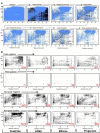LipidFinder: A computational workflow for discovery of lipids identifies eicosanoid-phosphoinositides in platelets
- PMID: 28405621
- PMCID: PMC5374061
- DOI: 10.1172/jci.insight.91634
LipidFinder: A computational workflow for discovery of lipids identifies eicosanoid-phosphoinositides in platelets
Abstract
Accurate and high-quality curation of lipidomic datasets generated from plasma, cells, or tissues is becoming essential for cell biology investigations and biomarker discovery for personalized medicine. However, a major challenge lies in removing artifacts otherwise mistakenly interpreted as real lipids from large mass spectrometry files (>60 K features), while retaining genuine ions in the dataset. This requires powerful informatics tools; however, available workflows have not been tailored specifically for lipidomics, particularly discovery research. We designed LipidFinder, an open-source Python workflow. An algorithm is included that optimizes analysis based on users' own data, and outputs are screened against online databases and categorized into LIPID MAPS classes. LipidFinder outperformed three widely used metabolomics packages using data from human platelets. We show a family of three 12-hydroxyeicosatetraenoic acid phosphoinositides (16:0/, 18:1/, 18:0/12-HETE-PI) generated by thrombin-activated platelets, indicating crosstalk between eicosanoid and phosphoinositide pathways in human cells. The software is available on GitHub (https://github.com/cjbrasher/LipidFinder), with full userguides.
Conflict of interest statement
Conflict of interest: The authors have declared that no conflict of interest exists.
Figures






References
Publication types
MeSH terms
Substances
Grants and funding
LinkOut - more resources
Full Text Sources
Other Literature Sources
Research Materials
Miscellaneous

